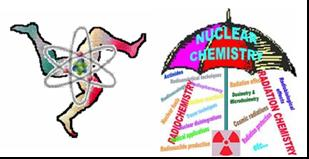Speakers
Keliang Shi
(Risø National Lab for Sustainable Energy, Technical University of Denmark, DK-4000 Roskilde, Denmark)
Xiaolin Hou
(Risø National Lab for Sustainable Energy, Technical University of Denmark, DK-4000 Roskilde, Denmark)
Description
Due to its high mobility, no stable isotope and long half-life (2.1×105 y), 99Tc is one of the most important radionuclide in safety assessment of radioactivity in environment as well as nuclear waste management. Because of the high enrichment of 99Tc in seaweed, it is widely used as a bioindicator for the marine research using 99Tc. These works require a rapid and accurate method for the sensitive determination of 99Tc in various environmental materials. Because of the volatile property and low concentration in the environment, the chemical separation and purification of Tc is the most critical step for the accurate determination of 99Tc. Here, we present an analytical method for 99Tc in seaweed sample. The analytical procedure includes four steps: (1) sample ash and 99Tc leaching, (2) co-precipitation pre-concentration of 99Tc, (3) Removal interferences mainly Mo and Ru, and (4) ICP-MS detection of 99Tc. 99mTc was used as a yield monitor to check the loss of 99Tc in each step. It was observed that the organic matrix of seaweed samples can be incinerated completely at 700 0C in 3h without significant loss of Tc. For Mo and Ru decontamination, extraction chromatography using TEVA resin was applied and a sufficiently high decontamination factors for Mo and Ru have been obtained in this work. The separated 99Tc in the eluate from the chromatograph was measured by ICP-MS with lower detection limit after one week decay of 99mTc. The total chemical yield of Tc in whole procedure is above 85% and analysis of a batch of samples (8-12) can be completed within 12h. The procedure was proved to be reliable and can be used in the environmental sample`s analysis by analyzing some standard reference materials.
Author
Keliang Shi
(Risø National Lab for Sustainable Energy, Technical University of Denmark, DK-4000 Roskilde, Denmark)
Co-authors
Per Roos
(Risø National Lab for Sustainable Energy, Technical University of Denmark, DK-4000 Roskilde, Denmark)
Wangsuo Wu
(Radiochemistry Lab, School of Nuclear Science and Technology, Lanzhou University, China)
Xiaolin Hou
(Risø National Lab for Sustainable Energy, Technical University of Denmark, DK-4000 Roskilde, Denmark)
